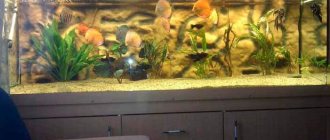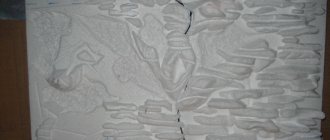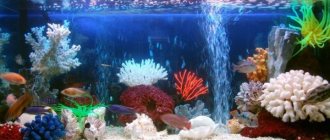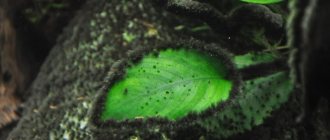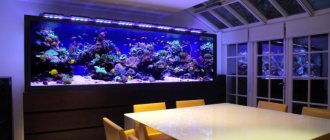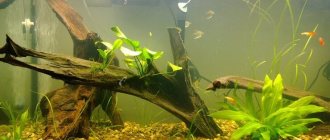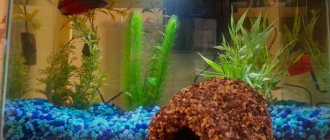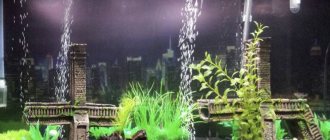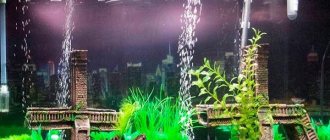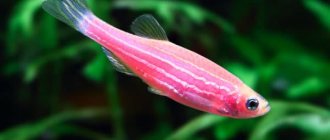Description of aquarium discus fish
Discus fish photo
Discus fish have been one of the most popular types of ornamental fish in the world for a long period of time. The body of this graceful fish has a rounded disk shape, flattened laterally. Depending on the variety, they reach a size of 15 to 25 cm in length. Discus fish have a small mouth with a steep, rising forehead. The eyes are small and usually bright red. The body has nine dark vertical stripes, and the main body colors range from dark brownish to blue and green shades. The dorsal and anal fins are rounded and have an elongated base; the hind fins are saber-shaped.
Through selective breeding, a large number of discus species with different body shapes, colors and patterns have been developed that are different from their wild-caught relatives. At the same time, they are much more adapted to life in aquariums and are a little easier to care for.
Aquarium
Due to their rather large size, the fish will require a large amount of water and a sufficient aquarium volume, from 200 liters for a couple and more than 600 liters for a flock of 6 pets. The size of the tank should be tall and long. You should not share an aquarium with other species; it is better to purchase a separate one.
Water parameters
These pets are very picky about the water temperature - it should not fall below 27 degrees, preferably it should be between 29-32 degrees. Soft and slightly acidic water is preferred: hardness – 6.0–6.6, acidity – 10–16 dGH. Pets are sensitive to nitrate levels in water.
Plants
The vegetation in the tank should not be too lush. Buy plants that can tolerate high temperatures and can filter water. For example, Anubias, Vallisneria.
Priming
Almost any soil is suitable: sand, stones, pebbles, special substrate. The main condition is the absence of sharp corners and notches on the ground. Pets will feel quite good even in the complete absence of soil mixture.
Equipment
The tank is equipped with a powerful filter, because pets are not known for being clean. You will also need a compressor for aerating the water, a heating device and a thermometer.
Lighting
Discus fish are not demanding on lighting, but it should not be too bright; it is better to use weak and diffused light.
Landscape depending on the type of discus
Once you have chosen an aquarium, you should decide on the type of discus fish you want to keep. The landscape surrounding them will depend on this:
If you choose Marlboro discus, which is a solid red color, then you should choose black gravel for them. This combination will give the aquarium a special charm and highlight the shade of the fish. You can complement the landscape with several dark driftwood. For snow-white and turquoise fish species, it is better not to use gravel. It will give the discus a dirty look. It is better to choose driftwood and algae climbing from the bottom. You can pour sand there. The soil for golden discus should be a deep blue color. Combined shades of blue will look advantageous. You can put small soil at the bottom. Climbing plants with long stems will complement the picture.
You can attach the driftwood to the same wall as the background landscape. Large specimens should be selected.
Thin stems that are located on the surface of the water and branch downwards look great.
You can dilute the interior with bamboo or coconut leaves. As a last resort, you can replace them with a cheaper specimen - dried oak leaves.
Kinds
Since there is a wide variety of discus species in the world, their names correspond to the appearance or behavior of the fish. Basically there is practically no difference in content.
The following are the most popular morphs:
Cobalt
This species is predominantly blue in color with dark, shiny spots and stripes on the fins and body. It is often confused with the turquoise subspecies, but upon closer examination it becomes clear that cobalt is a shade of blue-blue and turquoise is green.
Green
It was discovered in 1904 by Pellegrin. Natural habitat is the center of the Amazon and the Putumayo River. The body color is greenish with yellow or gray shades and dark stripes from the back to the abdomen.
Heckel
Lives in tributaries of the Amazon. The color is cream with light horizontal stripes and one or more dark vertical stripes.
Blue
A natural subspecies that lives in the tributaries of the Amazon. It differs from others in its sky-blue color. The Blue Diamond breeding form is the most prized, but dye feed is often used to brighten the color.
Red
The color of this variety ranges from pale brown to brick. The most striking form of selection is “Red Schilingmanna”, the fiery red color of which is achieved by coloring additives and hormonal preparations. Without them, in the 2nd–3rd generation the color fades and becomes similar to the brown subspecies.
Pigeon blood
This name confuses many people, because they expect to see gray-blue fish, but what they get are yellow-pink pets with white spots. This subspecies received the name “Pigeon Blood” not because of its resemblance to pigeons, but because of the name of the “Pigeon Blood” ruby, popular at that time, because the color of the stone is similar to the deep red-orange color of the fish’s eyes.
Turquoise
This color variation is best known to aquarists in our country, because they were imported back in 1970 from Europe. On the body of the fish, spots and stripes are colored turquoise. In purebred individuals, the front part of the body is also colored turquoise.
Gold
The artificially bred species is characterized by a golden color. Particularly prized are individuals devoid of dark pigmentation - almost pure gold, for example, the “Super Gold” variation, which is especially beautiful.
Snake skin
A hybrid variety that gave rise to many other color types. It is characterized by a complex mesh pattern on a white background and red eyes. Among the color variations we can highlight Tiger Snakeskin with tiger stripes, Fine Line Snakeskin with refined lines and a more pronounced pattern.
Leopard
A hybrid variety created by crossing the red turkis and the green discus. The fish is an albino fish, has red eyes and white background scales covered with scarlet spots. In fact, she got her nickname for the pattern on her body. Leopard discus are very sensitive to light.
They grow large - an adult can reach 20 cm in length.
Feeding and diet of discus fish
Discus food Tetra
Discus fish are predatory fish and in their natural habitat feed mainly on small fish, fry and larvae, various aquatic insects and invertebrates.
There are no difficulties with feeding discus fish in aquariums. Healthy fish are not picky and readily eat food offered to them. Discus fish should be fed in small portions 2-3 times a day.
To maintain the rich coloration of discus fish, food must be varied. You need to be especially careful when handling live worms, because... they can be carriers of various infections.
Vitamins play an important role in the full development of discus fish: vitamin A – is responsible for the processes of regeneration and growth; vitamins B2, B6, B12 - are responsible for the development of color and vitality, also help in the breakdown of carbohydrates and converting them into energy; Vitamin C – is responsible for maintaining growth and healthy bone tissue (deficiency leads to pathological development of the gills). We recommend using specialized food for discus fish, which takes into account all their gastronomic preferences and, in fact, is the key to their health. For example, such as Tetra Discus.
Feeding Discus
It should be noted that when purchasing any dry food, you should pay attention to the date of its manufacture and shelf life, try not to buy food in bulk, and also store the food in a closed state - this will help to avoid the development of pathogenic flora in it.
What to feed discus fish?
Discus prefer food of animal origin. To feed them, live or frozen bloodworms, brine shrimp, gammarus and others are used. Experienced breeders feed their pets with minced meat prepared independently. Such minced meat usually includes beef heart, mussel and shrimp meat, fish fillet, vitamins, and various vegetables. Here you can take into account the gastronomic preferences of your pets.
After feeding the discus, all remaining food is removed. Protein foods, which these fish love so much, provoke an increase in the concentration of ammonia and nitrates, which has a bad effect on the well-being of discus fish. For the same reason, the bottom of the aquarium is cleaned as often as possible.
Given the skittish nature of discus fish, you need to keep an eye on whether they eat at all. More frisky neighbors in the aquarium can push them away from the food. This is another reason why it is better to keep discus fish separately from other fish.
You should be careful when choosing live food. Bloodworms and tubifex offered on the market can be carriers of various pathogenic infections or cause poisoning of fish.
Compatibility
The species is compatible with many fish due to its completely peaceful and non-aggressive temperament. But discus fish are often kept in a separate aquarium due to their heat-loving nature. Only a small number of fish consider this temperature suitable, so it is better to have its own aquarium for each species.
Sharing with active and territorial fish is not recommended. Often discus and angelfish are considered close relatives and are stocked in the same tank. But this is a mistake that will lead to stress and hassles. Angelfish have a more aggressive nature compared to calm discus fish.
Why is species-specific content better?
Experienced aquarists strongly recommend keeping fish kings in a species-specific home pond, which, in their opinion, is much more comfortable for pets and easier for owners. The main arguments for individual content are:
- Need for very warm water;
- The need for a daily water change of 30% - for most aquarium fish this is disastrous, as it causes severe stress;
- Slowness in eating - in the presence of neighbors, the risk that king fish will remain hungry increases significantly . The more active inhabitants of the aquarium will have time to eat the food before their slower comrades are satisfied;
- Low immunity - moving in neighbors threatens to infect pets with infections, since their natural defenses have been significantly damaged due to hybridization;
- The need for a very large area for maintenance - the minimum volume of a species tank starts from 500 liters. When the main pets have neighbors, the reservoir should be increased by another 150-200 liters.
Discus fish are very attractive, but only a professional or an amateur with extensive experience can handle them. They can choose neighbors, but it’s not always justified.
Breeding
Reproduction of discus fish in captivity is a rather complex process that requires preparatory work and attention from the aquarist.
For successful breeding, at least 8 individuals are usually acquired, which independently form monogamous pairs. Pairs can also be created artificially, but this method is less effective. In this case, completely healthy fish of the brightest colors are selected for spawning.
For successful spawning, it is recommended to place the already formed pair in a pre-prepared spawning tank. Of course, fish can lay eggs in a general aquarium, but in this case the chance of having numerous offspring tends to zero.
In order to get healthy offspring, you need to create conditions in the spawning area that are as close to natural as possible:
- The water should be very warm (29 - 30 degrees), with a low level of hardness (up to 6 dGH), low acidic (pH 6 - 6.2).
- A weak light (no more than 8 W) should be on constantly.
- The tank size must be at least 60 liters.
- No plants or soil required.
- Decorative elements include placing a clay tube or several flat stones on the bottom on which eggs can be laid. It is not recommended to use shell rock for this purpose - it releases lime into the water.
- The water needs to be changed daily. To replace, you need to use a liquid identical to the one already poured into the aquarium. Its temperature and all biochemical parameters must be the same.
- The spawning tank should be placed in the quietest place. If the fish get scared, they will simply eat all the eggs.
Discus spawning occurs in the evening. After a short courtship ritual, the female lays from 50 to 250 eggs, which are instantly fertilized by the male.
Discus is a fish that tends to care for its offspring. Therefore, after spawning, adult fish are not returned to the general aquarium. They take care of the clutch together - they remove spoiled eggs and constantly fan it with their pectoral fins.
The incubation period ranges from 2.5 to 4 days. The larvae will need another 3 days to swim on their own. The newly hatched fry first feed on skin secretions from the body of adult fish. Without harming their health, discus fish are able to feed their fry for up to 10 days. After this period, you can feed small fish with nauplii, cyclops and rotifers.
Interesting Facts
Discus fish are gregarious creatures, but they also need personal space. Therefore, larger and deeper ones are chosen to contain them.
Discus fish are almost the only fish species that feed their fry with a special skin secretion. Therefore, during the first days of life, the fry swim near their parents.
The consistency of discus fish is surprising. These fish form pairs at a young age, spawn and care for their offspring together.
Deliveries of live discus fish to Europe began in 1932; only in the second half of the 60s new varieties with original colors began to be developed.
Diseases
The main ailments of discus fish include:
Gill worms are flukes . Symptoms: timidity, restlessness, gills swell and stick or, on the contrary, protrude. The fish begins to choke. Treat with formaldehyde baths for several days or with a special product ALL-NATURAL MELAFIX, which is purchased at a pet store. Ampularia, which eat worm eggs, actively help in the fight against this evil.
Skin flukes . Symptoms: restlessness, swaying from side to side, the skin in some areas becomes matte with a gray or bluish tint, the fish stop feeding, the skin on the fins is destroyed and ulcers appear on the body. The treatment is the same as in the first case.
Intestinal diseases or hexamitosis . The causative agent is the protozoan diplomonas. You can get infected from sick fish or through bad food. Symptoms: excrement in the form of white transparent threads, the fish is lethargic, no appetite, the color darkens. Sores filled with pus or holes may appear on the head. The edges of the fins are decomposing. The diagnosis can only be confirmed after laboratory testing. Treat with metronidazole.
Bacterial infection . A sick fish's color darkens and its fins become curled. The mucous membrane thickens. The edges of the fins turn white. The fish hides in a corner and does not eat. If treatment is not started in time, the mucous membrane will peel off in rags, the eyes will become cloudy, and the fins and tail will begin to decompose. Such a fish falls on its side. Antibiotics are used for treatment: Ciprofloxacin, Tsifran together with Furazalidone.
Intestinal obstruction and dropsy. Diseases are not easy to distinguish. In both cases, the abdominal cavity swells. But with intestinal obstruction, the discus continues to feed until the intestines rupture, after which the fish quickly dies. With dropsy, the fish refuses to eat. Bulging eyes may appear, and stool often becomes mucous white. The cause of intestinal obstruction is poor and monotonous diet. The cause of dropsy is poor food and living conditions.
How to choose the right discus fish
It is no secret that discus is a difficult fish to care for and the foundations of its beauty and health are laid from a young age. Therefore, it is very important to select healthy specimens that can easily survive relocation to a new aquarium, reach large sizes and display bright colors.
Adult fish begin to show their beauty, so you should not expect amazing colors from the fry. It is best to choose teenagers for purchase, by which you can judge the future color.
Next, you should pay attention to the ratio of the eyes to the body. The fact is that if kept improperly and insufficiently fed, the fish can become “delayed.” It is almost impossible to feed such a fish to adult size; it will forever remain small and faded. The eyes that grow in fish regardless of body size will help identify such a specimen. If the fry has suspiciously large eyes, then you should refrain from purchasing.
The behavior of the fish is also important. Healthy discus should be active and should respond to a sharp sound when hitting glass. If, when a person approaches, the fish swim out of their hiding places and rise to the surface in search of food, this is a good sign, it means they are healthy and their appetite is fine. Ask the seller to feed the discus in front of you, or inquire about the nearest feeding time. You need to choose active fish with the best appetite.
Before purchasing, be sure to find out what the breeder fed the discus fish and what equipment he kept them with. Such knowledge can be extremely important, because these fish do not adapt well to new conditions and food, and the fry may even be delayed, refusing a new type of food.
Discus White Diamond.
How long does a discus fish live in an aquarium?
The lifespan of aquarium discus fish largely depends on the conditions under which they are kept. With proper care, timely hygienic treatment of the aquarium, maintaining temperature conditions, balanced and plentiful nutrition, the lifespan can be up to 30 years.
Sources
- https://aquaspecial.ru/akvariumnye-rybki/diskus
- https://fanfishka.ru/akvariumnye-stati/akvariumnye_rybki/1968-diskusy.html
- https://rybkies.ru/rybki/diskusy.html
- https://vplate.ru/akvariumnye-rybki/vidy/diskus/
- https://zverki.click/akvarium/rybki/akvariumnye-rybki-diskusy-soderzhanie-i-uhod.html
- https://FB.ru/article/272499/akvariumnaya-ryibka-diskus-ryiba-diskus-opisanie-foto-i-usloviya-soderjaniya
- https://aquariumguide.ru/freshwater-aquarium/fish/diskusy-soderzhanie-i-uxod.html
[collapse]
